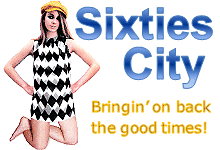

 |

|
|
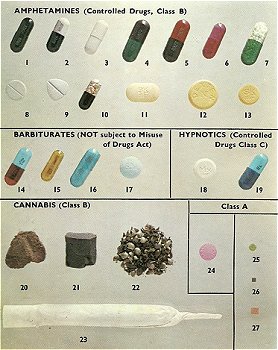 |
Almost unknown to the American society of the early Sixties and inexplicably
still legal until 1966, LSD (Lysergic acid diethylamide) gained widespread
recognition and notoriety in the USA. as a consequence of the very public
exploits of 'acid gurus' Ken Kesey and Timothy Leary who charmed 60s youth
with his mantra "Turn on, tune in, drop out". By the middle of the decade,
and quite insidiously, the use of LSD and marijuana had become quite common
amongst the youth of the entire country. In the UK the 'drug culture' started
with the increasing popularity of amphetamine 'pep pills', or 'speed'.
A form of 'pep pill' containing the drug Benzedrine was a barbiturate derivative medicine that was becoming widely misused in the Sixties. It had been in use perfectly legally during WW2 to ward off fatigue and tiredness and the post-war development of synthesised barbiturate drugs rapidly expanded. Doctors were prescribing the 'new' wonder drug, and subsequently its more sophisticated offshoots such as Dexedrine and Dexamyl, for many other purposes such as weight loss and enhancing self confidence. Another in this group, Secobarbital, was widely misused in the 1960s and 1970s and accidental overdose was associated with the drug. Judy Garland had been prescribed Seconal, the drug that killed her, off and on, since the Fifties. It had nicknames such as 'reds', 'red-devils' or seccies, but another nickname was 'dolls' and thus appears enigmatically in the title of Jacqueline Susann's novel 'Valley of the Dolls'. Amphetamine began to be used more prominently in these drug concoctions and very many varieties could be bought 'over the counter' in chemist shops. In order to get the energy for their 24 hour dance-til-you-drop lifestyle, Mods popularised the perceived common use of drugs. There was always something happening somewhere and the Mod drug of choice, amphetamine, kept them going for days. Purple hearts (Drinamyl) were a combined amphetamine/barbiturate that was commonly prescribed to women for anxiety and as a dietary aid. In the early to mid-Sixties they could be obtained from dealers at nightclubs and were used by many Mods as a stimulant to keep them going though their all-night dancing sessions. Following the well-publicised violence between Mods and Rockers in seaside resorts, newspapers reported on Mods emerging from clubs at 5am with dilated pupils and associating their use of purple hearts with the violence. This led to the criminilisation of their use by the government in 1964. |
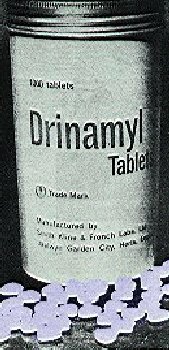 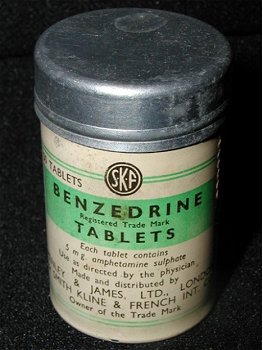 |
|
Other, more harmful, drugs were to follow, including amphetamine derivatives,
barbiturates and cocaine, pushing the concept of the use of 'mind-expanding'
drugs to gain some special insight into the world to one side in favour
of plain, frequently harmful, recreational use.
In 1966 The Drugs
(Prevention of Misuse) Act was again extended to include LSD and the hallucinogenics.
The 1967 Dangerous Drugs Act limited the ability of doctors to prescribe
to addicts and increased the police powers of 'stop and search'. An attempt
to decriminalise cannabis, chaired by Baroness Wootton, failed. Superstars of the day, musicians Jimi Hendrix and Janis Joplin, died directly as a result of such 'recreational drug' use. One of the original proponents of the use of LSD, Ken Kesey, had started to denounce its curative values by early 1967 but, by then, the habit had already taken a grip amongst youth cultures and its use had become too widespread to be so easily controlled. Much was written to try to justify, explain or vilify the use of these drugs, examining the use of substances such as peyote and mescaline in the religious ceremonies of native Americans and referring to the use, in ancient texts, of marijuana for both medicinal and spiritual purposes. One of the most famous of these was Aldous Huxley's 'The Doors of Perception' in which he describes his experimentation with mescaline in Mexico. The hallucinogenic group of drugs were called "psychedelics" and affected a person's perceptions, sensations, thinking, self-awareness and emotions. It included drugs such as LSD, mescaline, psilocybin mushrooms and DMT. Some of them come from natural sources, such as mescaline which is derived from the peyote cactus. Others, like LSD, were synthetic or manufactured. PCP [phencyclidine] was sometimes considered to be a hallucinogen because it had some of the same effects on the user, but it does not fit so easily into any one drug category. |
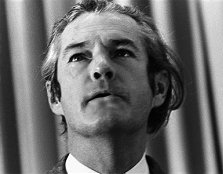 |
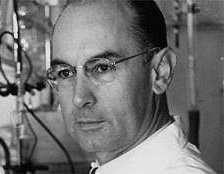 |
The most
well-known Sixties hallucinogen, LSD, is a chemical discovered by Swiss
chemist Albert Hofmann in 1938 at the Sandoz Laboratories in Basel during
research for medically useful ergot alkaloid derivatives (LSD is derived
from a fungus that grows on rye and other grains). Its 'psychedelic' properties
were unsuspected for many years until Hofmann, acting on what he called
a "peculiar presentiment", returned to work on the chemical and attributed
his discovery of the effects of the substance to the accidental absorption
of a tiny amount through his skin on April 16th 1943, which led to him testing
a larger amount. LSD was originally available in tablet form, but after it was made illegal it was more often used in straight liquid form (via oral, eyeball or mucous membrane entry), crystalline form (window-pane acid), as 'dots' on blotting paper, in a mixture with other drugs (e.g. dropping some onto marijuana before smoking) or a drop on a sugar cube. An LSD 'trip' could last anything from 2 to 12 hours, when the user experiences distorted vision, impaired judgment and, often, vivid hallucinations. Note: A bad psychological reaction to hallucinogenic drugs is quite common. The frightening sensation may last just a few minutes or many hours and can vary from mildly scary to absolutely terrifying. Flashbacks can occur years after the user has quit taking LSD, where a person may experience the effects of the drug without even taking it. The effects are completely unpredictable and can depend on the quantity taken, mood, personality and external surroundings. Physical effects include increased heart rate and blood pressure, dilated pupils, higher body temperature, sweating, loss of appetite, sleeplessness, dry mouth and shaking. Frightening emotional and mood swings or the feeling of several different emotions simultaneously can cause the user to panic. |
| LSD
was brought to the UK in 1952 when psychiatrist Ronnie Sandison visited
the labs of the drug company Sandoz, where Dr Hofmann worked, came home
with 100 ampoules in his bag and began to use them at Powick hospital, near
Malvern in Worcestershire, on certain patients with conditions such as compulsive
obsessive disorders or anxiety who did not respond to psychoanalysis. This type of drug was 'popularised' by military drop-out Timothy Leary who, in 1963, was sacked by Harvard University for his promotion of the drug and for supplying it to his students. Together with Richard Alpert, a former colleague, he opened a 'LSD Psychedelia' shop in New York and was instrumental in founding a 'church' called 'The League of Spiritual Discovery'. Leary even ran for the governorship of California in 1969 against Ronald Reagan, a campaign whose anthem was the specially-written John Lennon song 'Come Together. However, Leary was jailed on a drugs charge in Orange County and subsequently refused bail for the duration of the campaign. He was eventually 'sprung' from jail by a group of dissidents who called themselves 'The Weathermen' who were responsible for a series of bomb attacks on government facilities between 1969 and 1972. Another, even darker, LSD 'cult' was that of 'The Manson Family' who practised dangerous LSD 'brainwashing' techniques and culminated in the horrific 'Sharon Tate' murders. According to basic Hippie philosophy, LSD was an aid to users in shedding their sense of 'self' or 'ego' in an attempt to achieve a more peaceful existence which, in turn, reduced or eliminated tendencies towards violence and war. Unfortunately, there was also an increased tendency in users towards the belief that they could fly, a supposition that was not infrequently tested (somewhat unsuccessfully!) from the roofs of tall buildings. |
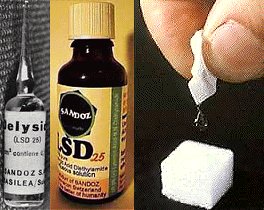 |
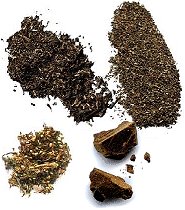 |
Grass,
pot, marijuana, cannabis, hashish or weed are common names for the crude
drug made from the plant Cannabis Sativa that contains the mind-altering
ingredient THC (delta-9-tetrahydrocannabinol) among more than 400 other
chemicals also found in the plant. A marijuana "joint" is made from the
dried particles of the plant and the amount of THC in the plant determines
the strength of the effect. The strength of today's marijuana can be as
much as ten times greater than the marijuana used in the Sixties and this
more potent plant increases the possibility of physical and mental effects
and health problems for the user. Hashish, or hash, is made by taking the resin from the leaves and flowers of the plant and pressing it into cakes or slabs. Hash is usually stronger than crude marijuana and may contain five to ten times as much THC. Pure THC is almost never available, except for research. Substances sold as THC on the street often turn out to be something else, such as PCP. Some immediate physical effects of marijuana include a faster heartbeat, bloodshot eyes, and a dry mouth / throat. Studies of marijuana's mental effects show that the drug can impair or reduce short-term memory, alter sense of time and reduce the ability to do things that require concentration, swift reactions, and coordination, such as driving a car or operating machinery. A common bad reaction to marijuana is the "acute panic anxiety reaction" which is an extreme fear of "losing control" which, in turn, causes panic. Although these symptoms usually disappear in a few hours, long-term regular users of marijuana may become psychologically dependent. The first conviction for cannabis use was in 1952 and, by 1967 had reached 2393 and 7520 by the end of the decade. However, these 'official' statistics only served to hide a much higher usage problem. Between 1953 and 1968 heroin addiction increased by about 10 times and the number of registered addicts in 1968 was 2,782. |
| 'Magic
mushrooms' containing psilocybin are a powerful, naturally occurring hallucinogenic.There
are about a dozen varieties of hallucinogenic mushrooms found growing in
the wild in the UK, the most popular being the 'Liberty Cap' (Psilocybe
Semilanceata). After picking, mushrooms are eaten raw, cooked, made into
a drink, or dried for later consumption but as the body quickly develops
a tolerance, continued use is unlikely. One of the biggest risks is in people picking and consuming poisonous mushrooms by mistake, which is very easily done. Once ingested, mushrooms generally cause feelings of nausea before the desired mental effects appear. The high from using magic mushrooms is mild and may cause altered feelings and distorted perceptions of touch, sight, sound and taste. Other effects can include nervousness and paranoia. Effects can be different during each use due to varying potency, the amount ingested, and the user's expectations, mood, surroundings, and frame of mind. On some trips, users experience sensations that are enjoyable. Others can include terrifying thoughts, and anxiety, fears of insanity, death, or losing control. |
 |
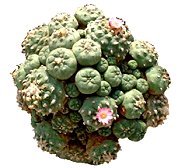 |
Mescaline
is one of the oldest psychedelics known to man and is the major active component
of the small dumpling cactus known as Peyote which is a spineless cactus
(Lophophora Williamsii) with a long root. Growing in
the south-western United States and Mexico, its crown, or 'button', is cut
from the cactus and dried into a hard brown disc. The disc, sometimes referred
to as a 'mescal button', contains a methoxylated amphetamine.
Mescaline induces a psychedelic state similar to that experienced using LSD and psilocybin, but with some different characteristics. The subject may experience altered thinking processes, an altered sense of self awareness and the passing of time and visual phenomena with eyes both open or closed. Enhancement of colour is often perceived, making it appear intense and brilliant. Recurring visual patterns seen during a mescaline experience include stripes, checkerboard effects, spikes, psychedelic or multicoloured dots and fractals varying from simple to very complex. Aldous Huxley described these fractal self-transforming amorphous shapes as 'like animated stained glass illuminated from light coming through the eyelids'. Like LSD, mescaline often induces distortions of form and kaleidoscopic experiences that tend to manifest more clearly with the eyes closed and under low lighting conditions, but all descriptions of visual 'trip' effects are necessarily extremely subjective. The generic term 'Drugs' includes alcohol and many other substances than the 'iconic' types listed here, and there were a number of drug 'rumours' as well, including flower seeds, magic mushrooms other than the Psilocybin and, somewhat famously, banana skins - or rather the scrapings from the inner skin of ripe bananas. |
'It couldn't
happen to me'..... maybe not, but it did to a lot of people - here's a list
of a few of the famous names of the Sixties who have died from drug-related
causes (including suicide), some of whom probably thought exactly the same thing.....
and no, it hasn't got any safer!
Chet Baker, Florence Ballard, Lester Bangs, Scotty Beckett, George Best, Dave
Bidwell, Mike Bloomfield, John Bonham, James Booker, Lenny Bruce, Tim Buckley,
Michael Clarke, Sonny Clark, Montgomery Clift, Brian Cole, Pamela Courson, Dorothy
Dandridge, Jesse Ed Davis, Desmond Donnelly, Nick Drake, Bobby Driscoll, John
Entwistle, Brian Epstein, Rick Evers, Rory Gallagher, Judy Garland, Bobby Hatfield,
Tim Hardin, Wynonie Harris, Alex Harvey, Jimi Hendrix, Bob Hite, Michael Holliday,
Howard Hughes, Brian Jones, Janis Joplin, Jack Kerouac, Frankie Lymon, Phil
Lynott, Steve Marriott, Clyde McPhatter, Joe Meek, Marilyn Monroe, Keith Moon,
Jim Morrison, Johnny O'Keefe, Christina Onassis, John Phillips, Elvis Presley,
James Ray, Johnnie Ray, Rachel Roberts, David Ruffin, George Sanders, Jean Seberg,
Edie Sedgwick, Judee Sill, Inger Stevens, Rory Storm, Screaming Lord Sutch,
Gary Thain, Dinah Washington, Danny Whitten, Alan Wilson, Kenneth Williams,
Natalie Wood.
|
Sixties
City does not recommend or condone the misuse of any drugs - they are
highly addictive or damaging and can kill you. You only have one life
- don't find out the hard way! |
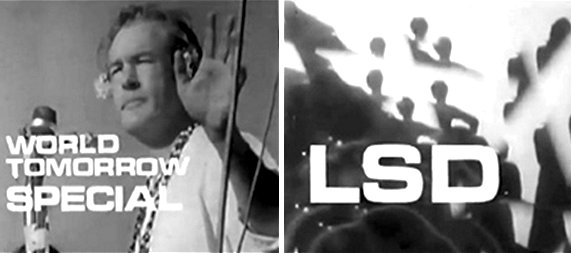 |
World
Tomorrow Special - 'LSD' - 1967 A 1967 Granada television documentary series broadcast in a late slot on Friday nights, this special edition of 'World Tomorrow', on LSD, was broadcast by Rediffusion (London) on Tuesday 7th February, in black and white, 9:40-10:25p.m. and included interviews with Timothy Leary, Richard Alpert and Allen Ginsberg. Other regions also screened the episode at various times. The introductory voice-over stated: 'Turn on, Tune In, Drop Out' - for this crowd of hip young Americans these six words are shorthand for an electrifying experience most of them know well, an experience called 'The Trip'. 'The Trip' is a drug-induced mental explosion that has changed their whole way of looking at the world, but for many other Americans the six words stand for something else - controversy, crime and terror. Turning on, tuning in and dropping out is what happens to you when you take a dose of the strange new drug called LSD..... LSD stands for dextro lysergic acid diethylamide, a chemical derived from a fungus that grows on rye. It is not addictive, like Heroin or Cocaine, but it's far more powerful in its effects. Taken in a pill, or on a sugar cube, it acts in an hour and lasts up to 24. During this time the user soars into another world where the consciousness is vastly expanded, or seems to be. This is the famous 'psychedelic experience'. Allen Ginsberg: "...are there wars on Earth? Still? Vietnam - like everybody losing control of their temper. Does anybody else want to create a hell? Perpetuate a hell? We might as well get out of our minds, which does mean (using) some LSD as a useful personal catalyst as something that does approximate a natural religious experience". Timothy Leary: "The experience that you have when you take LSD is similar to the experience that has been described by the great mystics and philosophers of the past. There's a sense of being in communion with powers greater than yourself - intelligence that far outstrips the human mind and energies which are very ancient. You have a sense of being brought into God's workshop, where the veil is pulled away and for the first time you see how things really are". |
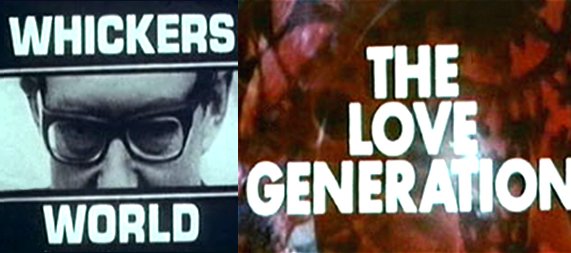 |
Whickers
World - 'The Love Generation' - 1967 'Whickers World' was a documentary series that ran on British television from 1958 to 1994. Presented by journalist and broadcaster Alan Whicker it reported on social interest stories from around the world. This documentary was made in San Francisco in 1967, covering the 'summer of love' and the Hippie counter-culture movement and included The Grateful Dead performing 'The Golden Road', being broadcast in colour by BBC2 from 8:25pm to 9:10pm on Saturday 9th September 1967. Alan Whicker's introduction: "No one really knows what's 'happening' in San Francisco, but this is 'where it's at'. Traditional home of 'the way out', today the mecca of happy hippies who are cracking the smooth silhouette of America's materialism with the ultimate weapon - with love..... Haight Ashbury, a crumbling corner of San Francisco, is where the action is. This is where the hippies began their march towards 'flower power' and the quiet revolution, a significant part of the American landscape today and a rallying point for the new irreverent way of life for those who preach the 'drop out' gospel, a community of beautiful people or, perhaps, a dark carnival. In Hippie colonies around the world, thousands of people are joining this 'far out' pursuit of happiness. So, as the 'square world' begins to adopt hippie fashions, let's take a thoughtful look at the 'love generation' in full flower, walking off the joy and pain of being young and poor in the richest place in the world amid a conforming society that distrusts the different. Where the living is easy and the jobs are waiting, Hippies 'turn on, tune in and drop out' to show distaste for a bland culture which seems to offer no ideal beyond that of acquisition. Everyone's competing, they say, nobody's living.... Hippie philosophy is hostile to hard drugs like Heroin, but based on psychedelic drugs - which provide instant mysticism - like LSD, Peyote and Marijuana. They swallow these mind-expanding drugs illegally while the coachfuls of tourists who daily come to stare at them stay legally hooked on booze, cigarettes and tranquilisers". |
|
|
All
Original Material Copyright SixtiesCity
Other individual owner copyrights may apply to Photographic Images |